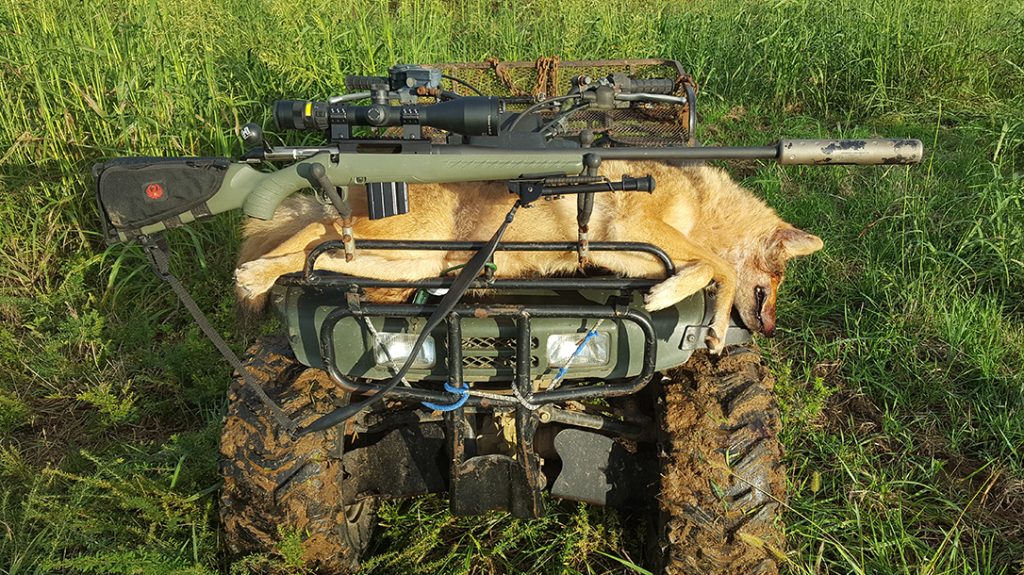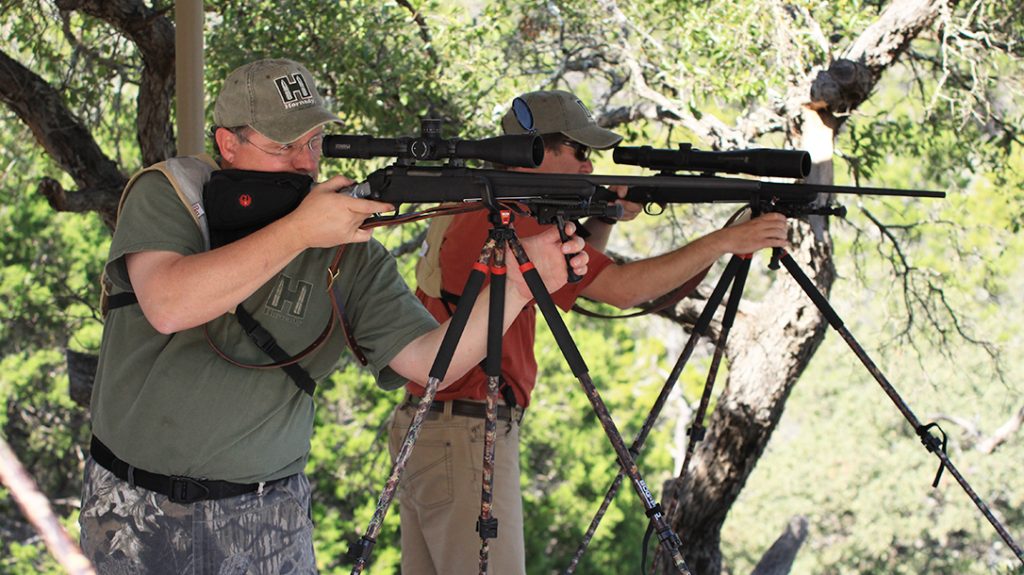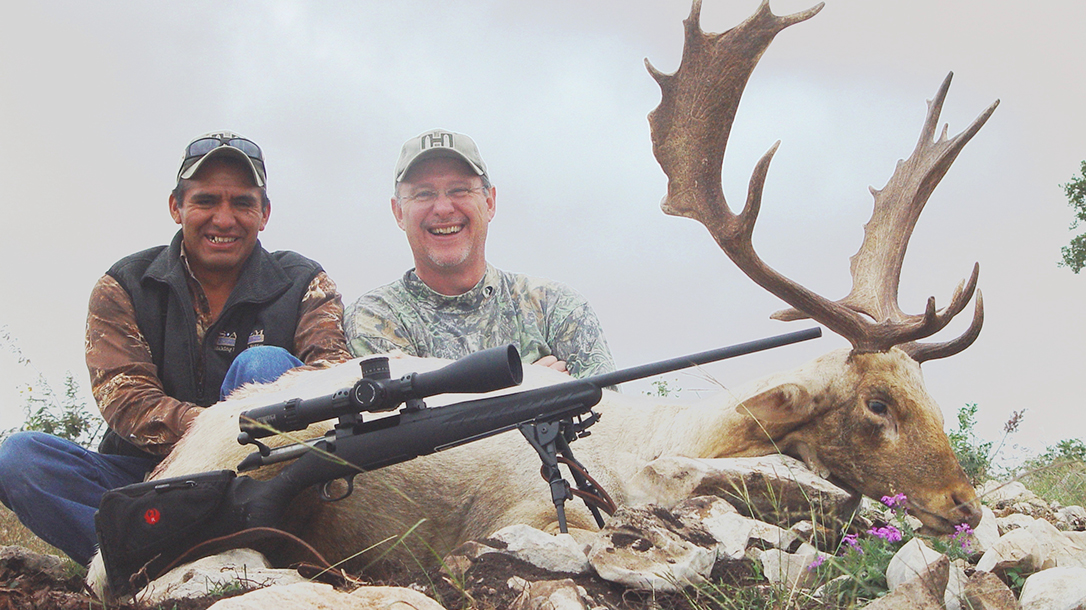I have been invited to many “industry” hunts over the past 30 years, but my first hint that this outing — hosted by Ruger for its American Rifle — would be different came several weeks prior, when I received an event schedule. Typically, magazine writers, editors and television hosts arrive in camp the afternoon of the first day, rush to change into hunting togs and head afield. I raised an eyebrow and read the schedule twice to be sure, but it was right there in black and white: Guest hunters would not get an opportunity to “put some hair in the scope” until the morning of day three. The instructors of the Sportsman’s All-Weather All-Terrain Marksmanship (SAAM) course held at the FTW Ranch in Barksdale, Texas, were certainly emphasizing their commitment to training and their motto: “You only have one first shot.”
The thing that brought us all to the FTW Ranch was the Ruger American Rifle in .308 Winchester—the company’s entry into the budget-priced bolt-action market back in 2011. In the years since, Ruger has gone back to the well several times and made the American Rifle great again and again. Today, Ruger offers 85 different centerfire and rimfire American variants—a tribute to the platform’s success.
In The Field With the Ruger American Rifle in .308
The first day of the SAAM course was spent in the classroom and on the range employing skills taught by owner Tim Fallon and retired U.S. Navy SEAL Doug Prichard. Most of the shooting was done from the prone position, with a hefty dose of proper use of supports like tripods and backpacks. We used six of the 21 ranges on the 12,000-acre Texas Hill Country ranch. Most targets were between 100 and 700 yards, but we did spend some time taking our .308s out to 1,000 yards. It was thrilling to dial in adjustments on our 3-15x50mm Steiner M5Xi scopes and make hits at distant ranges with lightweight, thin-barrel rifles.
Advertisement — Continue Reading Below
I got to know my hunting guide, Fredo Ruben, during the shooting sessions while he spotted and made wind calls. I told him that I wanted to hunt for a fallow deer buck. On the third morning we got into one of the ranch’s many elevated stands and waited for daylight. I was rather surprised when Alfredo told me to hold fire on a big buck as it strolled by the stand about an hour after daylight. My barely passable Spanish picked up that we were looking for something better. “Es no blanco” and “Muy grande blanco” finally got through, and I realized that we were targeting a very big white buck that Fredo had been watching on the ranch for several weeks.
Taking a Buck
We didn’t see the buck the first morning or evening, but we finally caught up with it late on the second morning. The buck was magnificent, and it was traveling with an equally impressive chocolate-colored buck. We scrambled to get into shooting position as the bucks worked through the thick cedar scrub on a facing hillside. I went prone, facing down a steep slope, and tried to get the buck lined up, but the shot wasn’t a good one. I held off, and we repositioned and spent the rest of the morning on the spotting scope trying to find the buck, to no avail.
Over the next couple of hunts, we got close to connecting on the buck, but wind, rain and distance thwarted any shooting opportunity. The final morning, Fredo and I found a high vantage point and spent some more time on the glass trying to find the buck. When we located it, we saw that it had a harem of does. We played cat and mouse with the herd, but all those eyes put them on the run.
Advertisement — Continue Reading Below
We scrambled to get into position to catch the group crossing over the top of the ridge. Does started running through an opening 85 yards away, and I got the Ruger up and ready. The silver-medal-sized buck gave me a running shot as it passed the opening in the brush, and I took it. The Ruger did its job and put the buck into a pile. It was ironic that I had to make a rather short-range running shot after several days of sniping at long ranges. It didn’t hurt that I had put more than 300 rounds through the rifle in the preceding days.
Ruger American Rifle Attributes

The term “ergonomic” gets overused when people are talking about a gun’s contours, but the Ruger American just feels right when I pull it into my shoulder. Over the past few years, I’ve tested several Americans, and I’m always pleased with the results. In fact, I have three that see regular hunting use. Ruger designed the rifle’s lightweight synthetic stock for quick, easy handling; it blends a classic look with modern forend contouring and grip serrations.
Advertisement — Continue Reading Below
The action is better than average for a gun in this price range. It typically takes me about 300 cycles with zero lubrication to get the bolt to smooth up appreciably. However, after that, it just gets better with use. The one-piece, three-lug bolt has a 70-degree throw that provides ample scope clearance and utilizes a full-diameter bolt body and dual cocking cams for smooth, easy cycling from the shoulder once it is broken in.
The Ruger Marksman Adjustable trigger offers a crisp release with a pull weight that is user-adjustable between 3 and 5 pounds; this allows shooters to make that perfect shot. From the factory, the triggers typically break cleanly at about 3.25 pounds.
The Barrel and More
The cold-hammer-forged barrels on the centerfire variants have ultra-precise, five-groove rifling, providing exceptional accuracy, longevity and easy cleaning. The integral V-block Power Bedding system positively locates the receiver and free-floats the barrel—another critical accuracy upgrade.
Advertisement — Continue Reading Below
As you can see, the manner in which Ruger builds these rifles makes them accurate. The American Predator in 6.5 Grendel, for example, regularly creates 0.33- to 0.5-inch groups at 100 yards.
The next feature is one that takes me back a few years to the first Model 77 that I bought with money I earned pushing a lawnmower. Each American rifle has an easy-to-use tang safety that provides a quick release for fast shooting. I’ve lost track of the number of running whitetails I jumped and shot on the move with that old Model 77, but suffice it to say that your freezer and mine wouldn’t hold them all.
Finally, Ruger installed a soft rubber buttpad for maximum recoil reduction. The designers hollowed out its edges to reduce its “bite” into the shoulder during recoil.
Advertisement — Continue Reading Below
Endless Options

Ruger currently offers seven different Ruger American Rifle families: Standard, Predator, Compact, Magnum, Ranch and Go Wild Camo as well as Standard and Predator versions that come with Vortex Crossfire II scopes.
The Standard versions now come in both short- and long-action calibers—six to be exact. The models in .243, .270 and .308 Winchester, .30-06 Springfield and 7mm-08 Remington come with black synthetic stocks and matte black metal. Several distributor exclusives in those same calibers plus the 6.5 Creedmoor come dressed in Kryptek Nomad camo.
Advertisement — Continue Reading Below
Ruger really kicked the American Rifle into high gear with the Predator series; it offers a wide array of popular chamberings, green synthetic stocks and threaded barrels. Nine calibers are available: the .204 Ruger, .22-250, .223, 6mm and 6.5 Creedmoor, 7mm-08, .308, .243 and, my favorite, the 6.5 Grendel. A Kryptek Highlander camouflage version in .223 is available from Davidson’s as a distributor exclusive.
Heading to the “Ranch”
Ruger’s Ranch Rifle became synonymous with the Mini-14 introduced back in 1982. I’ve still got the first-year model I bought then with money I made cutting firewood and trapping. It made perfect sense for the American series to pick up the “Ranch” moniker when Ruger introduced a 16.12-inch-barreled version of this handy bolt gun. These carbines come in 5.56mm NATO, 300 Blackout, 7.62x39mm and the heavy-hitting .450 Bushmaster. The latter comes in tan, or you can have a Go Wild camo version as a distributor exclusive. All of these Ranch versions come with threaded muzzles. Also, the .450 Bushmaster has a muzzle brake installed to help tame recoil. You have a choice, too, of feeding the 5.56mm or 300 BLK versions from a flush-fit magazine or a STANAG AR magazine. The American Ranch Rifle in 7.62x39mm accepts Ruger’s Mini Thirty magazines.
The American Magnum versions come in two calibers: .300 Winchester Magnum and .338 Winchester Magnum. The latter is a TALO distributor exclusive. These heavy hitters tip the scales at 7.5 pounds, hold 3+1 rounds and sport 24-inch barrels with 5/8×24-tpi muzzle threading.
Advertisement — Continue Reading Below
If your taste leans towards camouflage, Go Wild’s I-M Brush patterns adorn seven models. Your caliber choices are 7mm-08, .30-06, .243, .308, 6.5 Creedmoor, .243, .300 Winchester Magnum and .450 Bushmaster. These rifles take AI-pattern magazines, except for the .300 Win Mag and .450 Bushmaster variants. The barrels and actions have a bronze Cerakote finish, too. All of these rifles have muzzle threading for various attachments as well.
Small Bores
Ruger currently divides its 25 American Rimfires into four families: Standard, Compact, Wood Stock and Target. The Standard model comes with a black synthetic stock that helps keep the weight down to 5.5 pounds. The 18-inch barrel has six-groove rifling in a 1-in-16-inch twist rate to stabilize .22 LR rounds. The rifles also accept Ruger’s 10-round rotary magazines or extended 25-rounders. The rear sight is adjustable for windage and elevation, and the front sight has a fiber-optic insert.
Ruger also offers .22 WMR and .17 HMR versions. You can choose a threaded muzzle for suppressor use and a stainless instead of blued finish. TALO is the sole source of the .22 LR version with a Muddy Girl pink camo stock. Meanwhile, the Shooting Store offers a rifle with a moss green stock chambered in either .22 LR or .22 WMR. The barrel lengths are either 22 or 18 inches.
Advertisement — Continue Reading Below
Eight different Compact models offer a 12.5-inch length of pull that is adjustable via stock inserts. Ruger offers the plain vanilla version in all three caliber choices. Also, distributor exclusives include options such as threaded muzzles, refined Williams peep sights and camouflage.
The Wood Stock model in .22 LR retails for about $100 more than the synthetic-stocked versions. Several distributor exclusives include options such as a satin stainless finish, carved scenes or what looks like higher-grade wood.
Target models come in all three caliber choices and feature black laminate stocks. There’s even a thumbhole version. The barrel length is 18 inches, and they all offer heavy barrels with threaded muzzles.
Final Thoughts on the Ruger American Rifle
Several years ago, Ruger’s Mark Gurney told me that when they locked their engineers into a room for nine months to design the first American Rifle; they were told that the rifle they designed “must be accurate, rugged and reliable.” They accomplished their goals, and then some. For more information on the Ruger American Rifle, please visit Ruger.com.






















